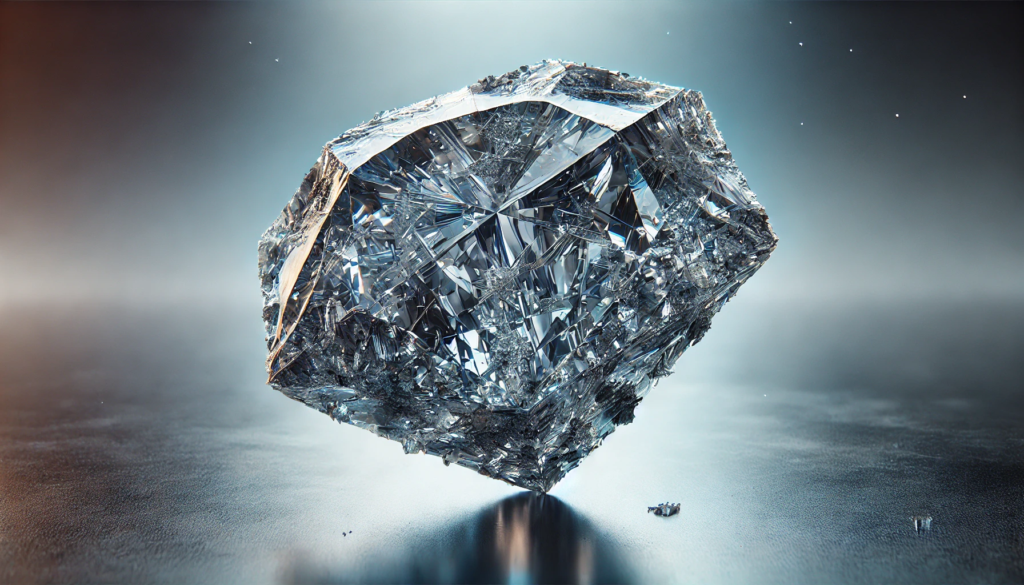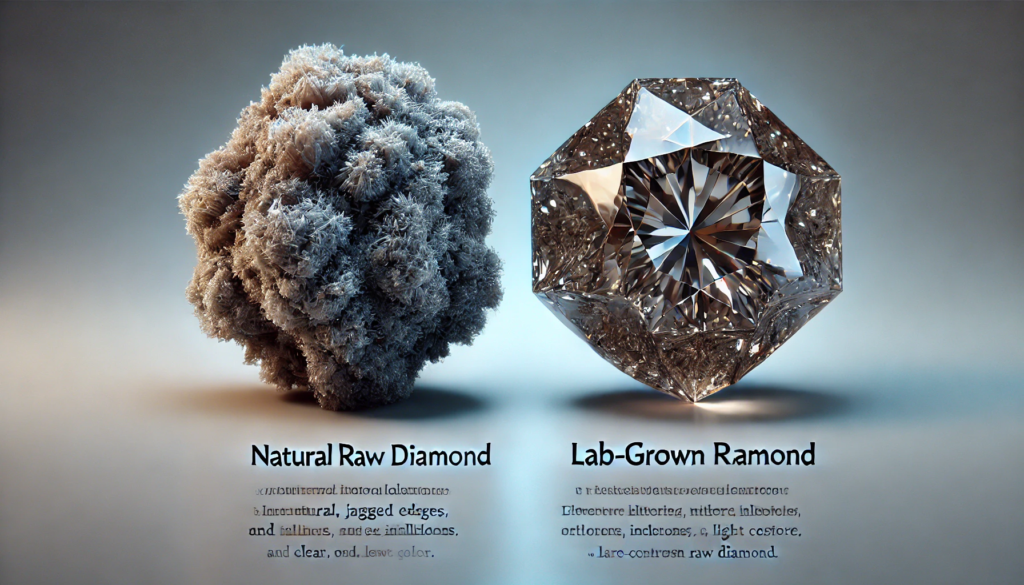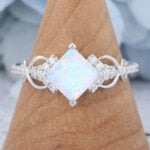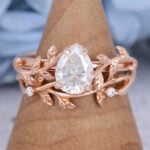A raw diamond, also known as a rough diamond, uncut diamond or unrefined diamond, is a natural diamond mined from an ore without being cut, polished or processed. Rough diamonds have a wide range of uses, and some rough diamonds can even be used directly in natural-style jewelry design like raw diamond ring . What does a raw diamond look like? When buying jewelry, how do you distinguish between a raw diamond and other gemstones?
What does A Raw Diamond Look Like - Physical Characteristics of a Raw Diamond
Color of Raw Diamond
The colors of uncut diamonds vary mainly due to chemical elements, crystal structure and radiation. Common colors of uncut diamonds are colorless (raw white diamond stone), yellow or brown, gray and black, blue, green red and pink and purple. Among them, colorless, blue, green, pink and red uncut diamonds are extremely valuable.
Shape of the Raw Diamond
Although raw diamond gemstone (rough diamond) has not been cut and polished, the original rough diamonds have different shapes, mainly flat crystals, triangular crystals, round or oval, octahedron, cube, rhombic dodecahedron and irregular shapes.

Impact of Raw Diamond Shapes on Value
The Transparency & Clarity of Raw Diamond
Natural raw diamond in rock is buried underground for a long time and are affected by inclusions, cracks, crystal structure and external surface characteristics. resulting in different levels of transparency. The raw diamonds can present the rarest and most valuable transparent crystals, medium quality translucent crystals, slightly transparent crystals and opaque crystals.
Luster & Reflection of Raw Diamond
Diamond has a high refractive index (about 2.42) and shows an extremely unique luster. The luster of raw diamond rocks is divided into Adamantine Luster (extremely bright and strong luster), Sub-adamantine Luster (slightly weaker than diamond luster), Greasy Luster (slightly greasy on the surface, not bright enough.) and Waxy Luster (the surface is a soft wax-like luster, lacking the strong reflection that diamonds should have.)
The reflectivity of unpolished rough diamond is far less than that of cut diamonds, but it is still affected by crystal structure and transparency. The reflection of raw diamonds is divided into Surface Reflection (bright spots or spots formed by light reflecting on the surface of raw diamonds.), Internal Reflection (reflected multiple times inside, but the internal reflection of raw diamonds is weak.) and Total Internal Reflection, TIR (light is completely reflected inside the diamond, making it look brighter.).
Surface Texture of Raw Diamond
The surface of raw form uncut diamond usually has naturally formed textures, nicks, cracks or mineral inclusions. The main types of surface texture of diamond in the rough are divided into Natural Facets (may appear as smooth small planes, usually formed naturally), Etch Marks (textures similar to “grooves” or “pits”, which look like they have been eroded by tiny acids), Mineral Inclusions (black, white or brown mineral deposits, usually minerals such as graphite and rutile.) and Fractures (may appear straight and accompanied by white or translucent halos).
What does A Raw Diamond Look Like?
Diamond in raw form is the most primitive, unpolished diamond. It is mined directly from the ground without being cut or polished, so its appearance is very different from the exquisite diamonds we often see. Because it has not been treated, raw diamonds look like ordinary mineral stones or pale yellow crystals, lacking the bright luster and high transparency of polished diamonds. Natural unpolished rough diamonds vary in shape, which may be regular octahedrons or irregular fragments, and have a wide variety of colors, including colorless, yellow, brown, green, blue and even black. Its surface may have naturally formed lines, depressions or small cracks, which are the result of long-term geological action, making each rough diamond unique.

What does A Raw Diamond Look Like - How to identify a raw diamond?
Hardness Test
To identify a rough diamond, check its hardness. Diamonds rank 10 on the Mohs scale and can easily scratch glass, metal, or other minerals, making this a simple way to test authenticity.
Crystal Structure & Shape
To recognize a raw diamond, observe its natural shape. Most raw diamonds have an octahedral, cubic, or irregular form with sharp edges. Unlike quartz, their surface often appears slightly greasy rather than glassy.
Light Reflection & Transparency
To spot a raw diamond, examine how it interacts with light. Unlike cut diamonds, raw diamonds do not sparkle but show strong internal reflections. They also have a high refractive index, meaning light bends significantly when passing through them.
Density & Sink Test
A raw diamond has a high density. When placed in a heavy liquid, such as a specific gravity solution, a real diamond will sink, while many other minerals will float. This test helps distinguish diamonds from similar-looking stones.
Heat & Conductivity Test
Diamonds are excellent heat conductors. When exposed to heat, a real diamond disperses it quickly and remains cool to the touch, while other minerals may heat up. Some professional testers use thermal conductivity devices to confirm authenticity.
Where are Raw Diamonds Found?
Raw diamonds are primarily found in kimberlite and lamproite pipes, deep within the Earth’s crust, where extreme heat and pressure create ideal conditions for their formation. Major diamond-producing countries include Russia, Botswana, Canada, and South Africa, where volcanic activity has brought these precious stones closer to the surface over millions of years. Some diamonds are also found in riverbeds and coastal deposits, having been carried away by natural erosion.
What does A Raw Diamond Look Like - Natural vs. Lab-Grown Raw Diamonds
Natural and lab-grown raw diamonds differ in formation, color, clarity, and shape. Natural diamonds take billions of years to form under extreme pressure, while lab-grown ones are created in months using high-tech methods. Large rough diamonds from nature often have irregular shapes, unique inclusions, and a wider range of colors, including rare hues like deep yellow or blue. In contrast, lab-grown diamonds tend to have more uniform shapes, fewer inclusions, and more consistent colors. The meaning of ‘diamond in the ruff’ symbolizes hidden potential, much like an unpolished rough diamond before cutting and refining.

What does A Raw Diamond Look Like - Raw Diamonds vs. Other Similar Minerals
Raw Diamond vs Quartz
Raw diamonds and quartz may look similar but have distinct differences. Diamonds have a higher hardness (10 on the Mohs scale) and can scratch almost any material, while quartz ranks at 7 and is much softer. In appearance, huge rough diamonds often have a greasy luster, whereas quartz has a glassy shine. Diamonds also exhibit strong light dispersion, creating brilliance when cut, while quartz lacks this effect. Additionally, quartz is more commonly found in various colors, while raw diamonds are rarer and often more valuable.
Raw Diamond vs Cubic Zirconia & Moissanite
Raw diamonds, cubic zirconia, and moissanite differ in hardness, formation, and brilliance. Diamonds, naturally formed over billions of years, rank 10 on the Mohs scale, while moissanite (9.25) and cubic zirconia (8-8.5) are softer. Raw diamonds have irregular shapes and natural inclusions, whereas cubic zirconia and moissanite are more uniform and flawless. Moissanite also has higher light dispersion, creating a stronger rainbow-like sparkle.
Also Read: Moissanite vs Lab-Grown Diamond – A Comparison of Origin, Price, Appearance and Durability
How Raw Diamonds Are Processed for Jewelry?
Raw diamonds go through careful processing before being used in fine jewelry. They are evaluated for quality, then precisely cut and polished to maximize brilliance. Advanced techniques shape them into ideal forms for diamond engagement rings &wedding bands, and fine jewelry. Once polished, they are set into elegant designs to enhance their beauty and value.
What does A Raw Diamond Look Like - The Rarity and Value of Raw Diamonds
Raw diamonds are rare because they take billions of years to form under extreme geological conditions. High-quality rough diamonds with good clarity and unique shapes are especially scarce. The price of a 1 carat raw diamond depends on its quality—industrial-grade stones may cost as little as $100 per carat, while gem-quality rough diamonds range from $300 to over $1,000 per carat. Rare colors like blue, pink, or green increase their value significantly. Large, high-quality raw diamonds are even rarer, making them highly sought after by collectors and investors.
What does A Raw Diamond Look Like - Uses of Raw Diamonds
- Jewelry & Luxury Accessories:Raw diamonds are used in unique, uncut jewelry pieces, such as rings, necklaces, and earrings, valued for their natural beauty and organic shapes.
- Industrial Applications: Raw diamonds are widely used in construction, mining, and precision manufacturing, where durability and strength are crucial.
- Scientific & Technological Uses: Exceptional thermal conductivity of Raw diamonds make them ideal for heat dissipation in electronics.
- Investment & Collection: Collectors and investors seek large rough diamonds for their rarity and potential appreciation in value. Unique or colored raw diamonds are particularly desirable in auctions and private collections.
Conclusion
Rough diamonds have their own unique characteristics, the appearance is also very easy to distinguish. Knowing what does a raw diamond look like can help you buy an accurate diamond product.
FAQs About What does A Raw Diamond Look Like
How to tell raw diamond from quartz?
The key difference between quartz and diamond is hardness—diamonds (Mohs 10) can scratch quartz (Mohs 7). Diamonds have a greasy or adamantine luster, while quartz has a glassy shine. Raw diamonds often appear octahedral, whereas quartz forms hexagonal crystals.
How much is a raw diamond worth?
The price of a raw diamond depends on size, quality, and color. Industrial-grade rough diamonds may cost $100–$300 per carat, while gem-quality ones range from $300 to over $1,000 per carat.
What is uncut diamond called? What does an uncut diamond look like?
An uncut diamond is called a raw diamond or rough diamond. It typically has a dull, greasy luster with irregular or octahedral shapes, lacking the brilliance of a polished diamond.
Can you tell if a raw diamond is real at home?
Yes, you can try a few tests at home, such as checking hardness (diamonds can scratch glass), observing crystal structure, and performing a water or density test. However, professional evaluation is recommended for accuracy.
Are raw diamonds rarer than cut diamonds?
Raw diamonds are not necessarily rarer than cut diamonds, but high-quality rough diamonds with excellent clarity, color, and size are much harder to find, making them valuable.
 Christmas: 25% off All ltems · Code AFJ25 ·Ends Dec 30 30% off All Items ·On Orders Over $600 – Code AMANDA30
Christmas: 25% off All ltems · Code AFJ25 ·Ends Dec 30 30% off All Items ·On Orders Over $600 – Code AMANDA30


